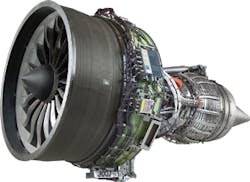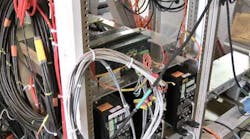Turbine Technology: The GEnx Engine
There are two models of GE's GEnx engine: the GEnx-1B engine which will provide power for the Boeing 787 family of aircraft, and the GEnx-2B engine which will provide power for the 747-8 aircraft. Testing of the GEnx-1B engine began in March 2006 and testing of the GEnx-2B engine began in 2008. By January 2010, the GEnx program has accumulated more than 7,800 hours and more than 10,500 cycles during testing. This included flight testing on the GE 747 flying test bed, where both of the engines have completed a combined 130 flights and more than 700 flight hours. Certification of the GEnx-1B engine occurred in March 2008 and certification of the GEnx-2B engine is planned for this year.
The two engine models share a common engine core, but do have some model-to-model differences. The GEnx–1B engine fan is 111 inches in diameter and produces about 70,000 pounds of thrust, and the GEnx-2B engine fan is 104 inches in diameter and produces about 67, 000 pounds of thrust. Another difference is that functions previously served by bleed air, now use electrical power from the starter-generators mounted on the GEnx-1B for the 787 Dreamliner. This is not the case with the –2B model engine.
The GEnx engine is designed for the engine market currently served by GE's CF6-80C2 engine, which operates on many of today's wide-body jets. GE states there will be several advantages over the GE CF6-80C2, including a 15 percent reduction in specific fuel consumption (SFC), and a 35 percent improvement in exhaust gas temperature (EGT) retention. The GEnx has 30 percent fewer parts and is planned to remain on wing 30 percent longer. GE also states this engine will be 30 percent quieter. However, the noise footprint of an aircraft powered by GEnx engines will be as much as 50 percent smaller than the noise footprint of a Boeing 767 aircraft powered by CF6-80C2 engines.
AMT spoke with Tom Walker, GEnx program manager, for a look at some of the technology used on this engine. Walker says, "The GEnx uses the same basic architecture as the GE90-115B with several new features." The GEnx employs the two-spool design (LPT-LPC-fan and HPT-HPC) and 360-degree compressor casings. Walker explains that some of the features include third-generation composite fan blades, a new composite fan case, second-generation 3-dimensional aerodynamic (3-D aero) airfoils, a new twin-annular pre-swirl (TAPS) combustor, counterrotating high-pressure and low-pressure turbines, and an advanced engine diagnostic system. Additionally, new metal alloys, coatings, and cooling technologies have been introduced in an effort to extend the life of engine parts.
More composite engine parts
As engines grow in size so do the fans and they can become heavier. The fan blades for the GEnx are manufactured using composite material that makes the blades less dense, therefore lighter in weight. The wide-chord composite fan blades have a titanium shield on the leading edge to protect them against impact damage. The number of fan blades is 18 compared to 22 on the GE90-115B and 36 on the CF6-80C2. This also reduces overall engine weight. GE says the blades are virtually maintenance-free.
The fan case is manufactured from a fiber-braided composite-matrix material. The new composite case provides better containment, is highly resistant to damage, fatigue, temperature extremes, and corrosion. "The weight savings with the composite case is approximately 340 pounds per engine," Walker says.
Walker says, "The HPC has a pressure ratio of 23:1 — the highest in the industry." The engines use blisks or blades and disks that are one part, for stage 1, 2, and 5, which eliminates any dove-tail wear on these particular units. Also, powdered alloy disks extend the lives of life-limited parts (LLPs).
The engine has a twin annular, pre-swirl (TAPS) combustor which enables the fuel-air mixture to burn at a significantly lower temperature. This will minimize the formation of nitrogen oxide (NOx) and also carbon monoxide, unburned hydrocarbons, and smoke. The reduction of peak temperature variations will extend the life of the combustion liner and the turbine components downstream. In addition, the lower temperatures reduce liner cracking and eliminate the need for dilution holes and the stress concentrations they engender.
GE states the counterrotating HPT and LPT have proven more efficient than a unidirectional turbine in rig tests and in engine and flight-testing of earlier GE engines. In the GEnx engine, next-generation 3-D aero vanes, with contoured end-walls, are stated to enhance this efficiency. Walker says, "The parts count of the counterrotating turbine is reduced, and state-of-the-art cooling techniques minimize the cooling air requirement." New HPT shroud material increases hot corrosion resistance by 50 percent.
Environmental benefits
In the case of a twin-engine aircraft with GEnx engines installed, when the weight avoidance of the engine installation hardware is factored in, the savings due to the use of advanced composites and part reduction will exceed 800 pounds. This has a direct effect on the reduction in SFC, which also means more range or better payload. Reduction in harmful NOx will be approximately 40 to 50 percent, and fewer fan blades and a lower fan speed make for a quieter engine.
What about maintenance?
In an effort to reduce foreign object debris (FOD) damage and blade erosion, the engine is designed to direct much of the foreign matter entering the fan into the bypass air stream. The fan spinner also directs debris into the air stream while some smaller particles pass into the air stream through the variable bypass valve (VBV) doors.
Access to engine mounting bolts has been made easier for engine removal and replacement. A reduction in the use of safety wire is seen on the GEnx, and is not required on certain items such as borescope plugs, line replaceable units (LRUs), and fuel nozzles. Replacement of certain LRUs will only require a leak check.
The integral diagnostic capability of the engine provides the maintenance crews access to data that assists with troubleshooting and ultimately timely maintenance actions. The system captures data for many items such as fuel system trending and fault isolation, bearing degradation trending, lubrication oil filter replacement prediction, starter/ignition system deterioration, vibrations, modular performance, gas path anomalies, and improved fault isolation for LRUs.
Walker says, "At the module level we have maintenance in mind." The modular design of the engine is such that when extensive maintenance of the propulsor is required, the fan assembly can be separated from the propulsor, the propulsor can then be sent to a maintenance facility for repair work and the fan can be returned to service and installed on another propulsor.
To date GE has developed more than 80 individual repair procedures for the GEnx with a focus on line maintenance and module level maintenance. GE is developing an additional 85 repairs, including repair procedures that are focused on piece-part level repairs that will be required at the first restoration shop visit. GE plans to proactively continue repair development on the engine well into its life cycle.
GEnx training
Computer-based and hands-on line maintenance training on the GEnx-1B engine have been underway at the Customer Technical Education Center (CTEC) located in Cincinnati, OH, for approximately six months. Last month GE began computer-based and hands-on line maintenance training for the GEnx-2B engine customers. Students will have the opportunity to take basic line maintenance training via computer-based digital video discs (DVD) or via the Internet.
Hands-on training such as line maintenance, engine change, and borescope inspection is instructor lead at the CTEC with classes lasting from two to five days. Entry into service training is approximately two weeks in length. During 2009 about 160 students attended the GEnx-1B course, the majority being internal GE Aviation employees such as field service engineers and a few GEnx-1B customers. This year, more training is planned, with most customers sending their employees to training about six months before the engine enters into service for the operator.
Today's engine manufacturers are all developing new technologies to provide more fuel-efficient and environmentally friendly ways of powering the aviation industry. I'm sure many of you current and future aviation maintenance professionals will have an opportunity to become familiar with the GEnx engine in the years ahead.
GEnx is a trademark of General Electric Company.
Information for this article was provided by GE Aviation in Cincinnati, OH. Tom Walker is a GEnx program manager from GE's GEnx product line of engines. More information regarding the engine can be found at www.geae.com.



